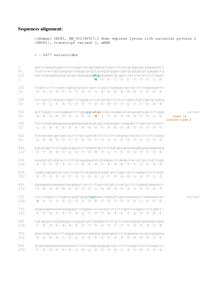KNOP1
Lysine-rich nucleolar protein 1 (KNOP1) is a protein which in human's is encoded by the KNOP1 gene. Aliases for KNOP1 include TSG118, C16orf88, and FAM191A.[1]
Gene[edit]
KNOP1 is located on the negative DNA strand of chromosome 16 at 16p12.3. It spans 15.21 kb, from 19729556 to 19714347 and has 6 exons which are alternatively spliced in the RNA to create three main transcript isoforms.[2] Two of the KNOP1 isoforms, B and C, lack exon 1, shifting the start codon used to the one found in exon 2, and so the proteins encoded by these lack sequence at N-terminus. Isoform C also does not contain exon 4, which encodes the C-terminal DUF5595 domain.
Gene Neighborhood[edit]
The genes surrounding KNOP1 are VPS35L which is upstream and IQCK which is downstream of KNOP1. The IQCK gene was identified to be a potential candidate for obsessive-compulsive disorder in a genome-wide association study.[3] The VPS35L encodes the protein VPS35L that acts as a component of the retriever complex.[4]
Gene Expression[edit]

KNOP1 has high levels of expression in the superior cervical ganglion,[6] testis, placenta, and in early stages of hear and lung development.[7] KNOP1 showed low levels of expression in the liver and pancreas.
Species distribution[edit]
There are many orthologs of KNOP1 in many different species of animals but not in the other kingdoms. No paralogs of KNOP1 were found. Table 1 lists select KNOP1 orthologs.
| Genus, Species | Divergence from Homo sapiens (MYA)[8] | NCBI accession number | Sequence Length (AA) | Sequence Similarity to Homo sapien KNOP1[9] |
|---|---|---|---|---|
| Homo sapiens | -- | NP_001335456.1 | 518 | 100% |
| Pan paniscus | 6 | XP_034795825.1 | 604 | 85.1% |
| Mus musculus | 89 | NP_075686.2 | 532 | 65.8% |
| Lagenorhynchus obliquidens | 94 | XP_026953897.1 | 454 | 72.6% |
| Galemys pyrenaicus | 94 | KAG8513613.1 | 534 | 67.1% |
| Phyllostomus discolor | 94 | KAF6125017.1 | 434 | 64.3% |
| Monodelphis domestica | 160 | XP_016279153.1 | 601 | 47.1% |
| Ornithorhynchus anatinus | 180 | XP_028910011.1 | 544 | 47.2% |
| Tyto alba | 318 | XP_042654773.1 | 627 | 42.1% |
| Gallus gallus | 318 | XP_004945520.2 | 548 | 32.4% |
| Bufo bufo | 352 | XP_040296565.1 | 513 | 37.7% |
| Danio rerio | 433 | XP_687135.1 | 475 | 40.4% |
| Branchiostoma floridae | 637 | XP_035694713.1 | 666 | 34.2% |
| Owenia fusiformis | 787 | CAC9610945.1 | 553 | 34.7% |
Protein[edit]
The exact function of KNOP1 is not yet understood it is hypothesized to mimic nucleostemin, a nucleolar protein linked to the proliferation potential of stem cells.[10] The protein is 518 amino acids long,[11] Isoform B is 458 amino acids,[12] and Isoform C is 435 amino acids.[13] It has a molecular weight of 58 kdal and an isoelectric point of 9.92 [14] The protein is rich in lysine[15] and has a lysine-rich region from amino acid 123–355.[16] There is a region of the protein that interacts with the protein ZNF106.[17] Some papers have associated it with the surface of the condensed chromosomes.[18]
Domains[edit]

KNOP1 has two domains Duf5595 (Not found in isoform C) and SMAP located at the end of the protein.[20] DUF5595 is found in Nude C 80 (Ndc80) proteins which can be found in species such as Homo sapiens. Ndc80 protein complexes are a core component of the end-on attachment sites for kinetochore microtubules.[21] SMAP (Small acidic protein family) is found in eukaryotes, and is approximately 70 amino acids in length. There is a single completely conserved residue G that may be functionally important at G441 [22]

Interacting protein[edit]
KNOP1 has been shown to interact with ZNF106[23] and has been confirmed by Grasberger, H., & Bell, G. I.[24] This study concluded that the rapid downregulation of KNOP1 expression during in vitro terminal differentiation coincides with a loss of nucleolar ZFP106.
References[edit]
- ^ GeneCards (https://www.genecards.org/cgi-bin/carddisp.pl?gene=KNOP1)
- ^ (NCBI Gene (https://www.ncbi.nlm.nih.gov/gene/400506#genomic-context)
- ^ U.S. National Library of Medicine. (n.d.). IQCK IQ motif containing K [Homo sapiens (human)] - gene - NCBI. National Center for Biotechnology Information. Retrieved December 18, 2021, from https://www.ncbi.nlm.nih.gov/gene/124152
- ^ McNally, K. E., Faulkner, R., Steinberg, F., Gallon, M., Ghai, R., Pim, D., Langton, P., Pearson, N., Danson, C. M., Nägele, H., Morris, L. L., Singla, A., Overlee, B. L., Heesom, K. J., Sessions, R., Banks, L., Collins, B. M., Berger, I., Billadeau, D. D., Burstein, E., … Cullen, P. J. (2017). Retriever is a multiprotein complex for retromer-independent endosomal cargo recycling. Nature Cell Biology, 19(10), 1214–1225. https://doi.org/10.1038/ncb3610
- ^ NCBI GEO (https://www.ncbi.nlm.nih.gov/geo/tools/profileGraph.cgi?ID=GDS596:213235_at)
- ^ NCBI GEO (https://www.ncbi.nlm.nih.gov/geo/tools/profileGraph.cgi?ID=GDS596:213235_at)
- ^ NCBI RNA-seq data (https://www.ncbi.nlm.nih.gov/gene/400506#genomic-context)
- ^ TimeTree (http://www.timetree.org/)
- ^ NCBI BLAST
- ^ Grasberger, H., & Bell, G. I. (2005). Subcellular recruitment by TSG118 and TSPYL implicates a role for zinc finger protein 106 in a novel Developmental pathway. The International Journal of Biochemistry & Cell Biology, 37(7), 1421–1437. https://doi.org/10.1016/j.biocel.2005.01.013
- ^ NCBI Protein (https://www.ncbi.nlm.nih.gov/protein/1143077058)
- ^ NCBI KNOP1 Isoform B (https://www.ncbi.nlm.nih.gov/protein/1142736531)
- ^ NCBI KNOP1 Isoform C (https://www.ncbi.nlm.nih.gov/protein/NP_001335461.1)
- ^ Expasy-Compute pI/Mw (https://web.expasy.org/compute_pi/)
- ^ Statistical Analysis of Protein Sequences (https://www.ebi.ac.uk/Tools/seqstats/saps/)
- ^ Motif Scan (https://myhits.sib.swiss/cgi-bin/motif_scan)
- ^ UniProt (https://www.uniprot.org/uniprot/Q1ED39)
- ^ Larsson, M., Brundell, E., Jörgensen, P. M., Ståhl, S., & Höög, C. (1999). Characterization of a novel nucleolar protein that transiently associates with the condensed chromosomes in mitotic cells. European journal of cell biology, 78(6), 382-390.
- ^ ProSite (https://prosite.expasy.org/cgi-bin/prosite/mydomains/)
- ^ MOTIF Search (https://www.genome.jp/tools/motif/)
- ^ DUF5595 (https://www.ncbi.nlm.nih.gov/Structure/cdd/cddsrv.cgi?uid=pfam18077)
- ^ SMAP (https://www.ncbi.nlm.nih.gov/Structure/cdd/cddsrv.cgi?uid=pfam15477)
- ^ String Protein-Protein Interaction Networks(https://string-db.org/cgi/network?taskId=bKzRFr03O9Lu&sessionId=b92QrR5MM6wa)
- ^ Grasberger, H., & Bell, G. I. (2005). Subcellular recruitment by TSG118 and TSPYL implicates a role for zinc finger protein 106 in a novel developmental pathway. The international journal of biochemistry & cell biology, 37(7), 1421–1437. https://doi.org/10.1016/j.biocel.2005.01.013

